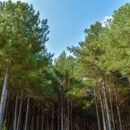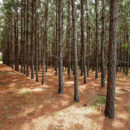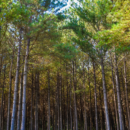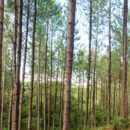FNC News
Enhancing Timber Growth: The Importance of First Time Thinning
The first time you thin your pine plantation is extremely important, because it sets up your stand for the life of the stand. Removing too much or too little will greatly impact future timber growth and sales.
As young pine stands approach 15 years of age, they become stagnated and require their first thinning. This involves removing the forked, suppressed, diseased and inferior trees, leaving the better-quality timber for future growth and sales. These stands would require subsequent thinning every 5-7 years thereafter, to age 35.
It is important to note that there is not a one-to-one relationship between the number of trees to the volume of wood. We recommend removing every fifth row in plantations or establishing a lane approximately every 60 feet in naturally regenerated stands. Then, remove only the suppressed and inferior trees in the remaining area between the down rows.
Ideally, you would want to remove only the suppressed and inferior trees and leave all the dominant superior trees which will become sawlogs. However, logging equipment requires lanes throughout the stand for harvesting and removal. Using the rows in which the trees were planted works well for these lanes, known as “down rows.”
These down rows contain both dominant and suppressed trees. It’s important to keep the number of down rows to a minimum to avoid removing too many future sawlog trees. To fully relieve stagnation and minimize down rows, the suppressed trees in the remaining residual rows also need to be removed.
We recommend removing no more than every fifth row, lightly thinning the rows in between to a basal area of between 80 to 100 square feet per acre. The basal area (BA) of a tree is the cross-sectional area of the trunk 4 1/2 feet above the ground, or the per acre sum of the basal areas of the trees on an acre and is used as a measure of forest density.
This removes up to one-half of the trees in a first thinning, but only 25-30% of the volume, simply because you are removing the smaller suppressed trees in the residual rows.
Thinning by removing every third row may remove only 33% of the trees, but this could include up to 50% of the volume due to the larger dominant trees in those rows. Thinning by removing every other row is devastating to future sawlog production.
All pine plantations and naturally regenerated pine stands develop differently based on site conditions, competition, and other factors. To avoid over-thinning during the first thinning, it’s best to take basal area samples of the stand beforehand.
Ready to enhance the growth and health of your pine plantation? Consult with our Foresters to ensure you’re making the best decisions for your stand’s future. Contact us today!
More News
Get in Touch




